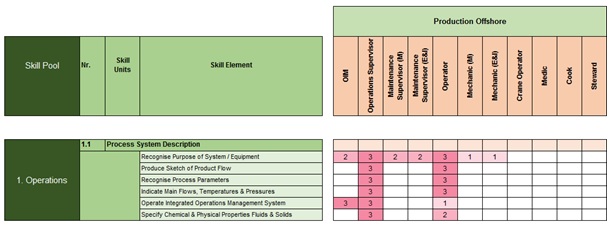Job profiles
Each employee in the oil & gas business is unique and has his own talents that can be translated into a personal profile. This profile is basically formed by his (school) education and work/life experience.
In reality a personal talent profile does not always meet the requirements of the organisation this person is working for. In some fields the employee may be over-talented and in other fields under-talented. The first one is a bonus for the organisation and the second one may be of serious concern, especially when this applies to safety critical activities.
Therefore, Job Profiles are needed to establish the minimum standards for each employee.
Ideally the personal profile should match the minimum requirements as laid down in the Job Profile.
In real life there will always be gaps between the two profiles and these gaps need to be closed.
Constructing Job Profiles
Using the Skill Unit Catalogue as the basis, Job Profiles can be developed for each person in the organisation. It is important that Job Profiles are made available for each level/rank in order to establish that all relevant Skill Units are covered.
Example:
Positions covered by Job Profiles on an Offshore Platform:
- - OIM
- - Operations & Maintenance Supervisors
- - Operators & Technicians
- - Crane Operator
- - Medic, Cook, Steward, etc.

Job Profiles shall identify the minimum professional, HSE, Business and managerial skills that are relevant, and define the required Levels of Performance in terms of “Awareness”, “Knowledge”, “Skill”, “Master” or “Lead”.
The “Mastery” and “Lead levels do in general not apply to Operators, Technicians and Supervisors, as it is not expected that this group will be required to solve significant, complex, non-routine problems.
The Levels of Competence are cumulative, i.e. employees satisfying the “Knowledge” criteria must also satisfy the “Awareness” criteria etc.
For roles/positions with similar range of responsibilities/accountabilities the same Job Profiles may be used.
When Job Profiles are available they can be used for e.g.:
- - Identifying minimum requirements for the job
- - Establishing learning/training needs
- - Developing employees to the next level/rank
- - Preparing structured questions for interviewing new recruits
- - Aligning the “Skills” section in Job Descriptions with the Job Profile
Capability Management
When bringing together all Job Profiles, a matrix will emerge with a complete overview of the spread of all required minimum skills (see sample).
This can be extremely helpful when looking at the capability of the organisation as a whole. Not sufficient employees with a “Skill” level may create a problem for the safe and efficient operation of the facilities, whereas too many employees with the “Skill” level may not be required for the organisation (possibly resulting in unnecessary additional costs for training employees to reach the “Skill” level).
In general the following rules will apply:
- All skills in the Skill Unit Catalogue should somehow be covered by a function in the organisation
- There should not be too many “Skill” ratings across the organisation for a particular Skill Unit
